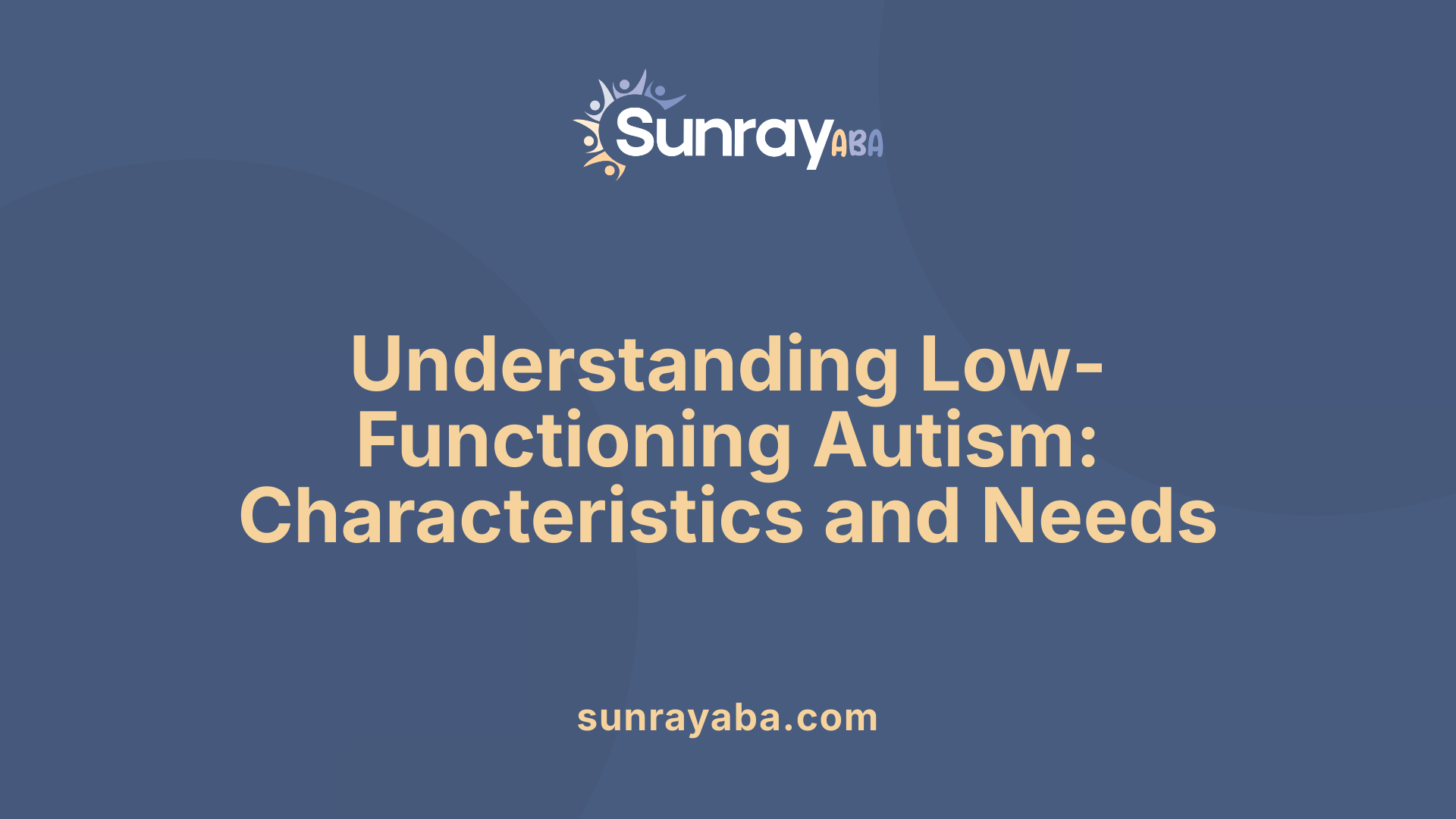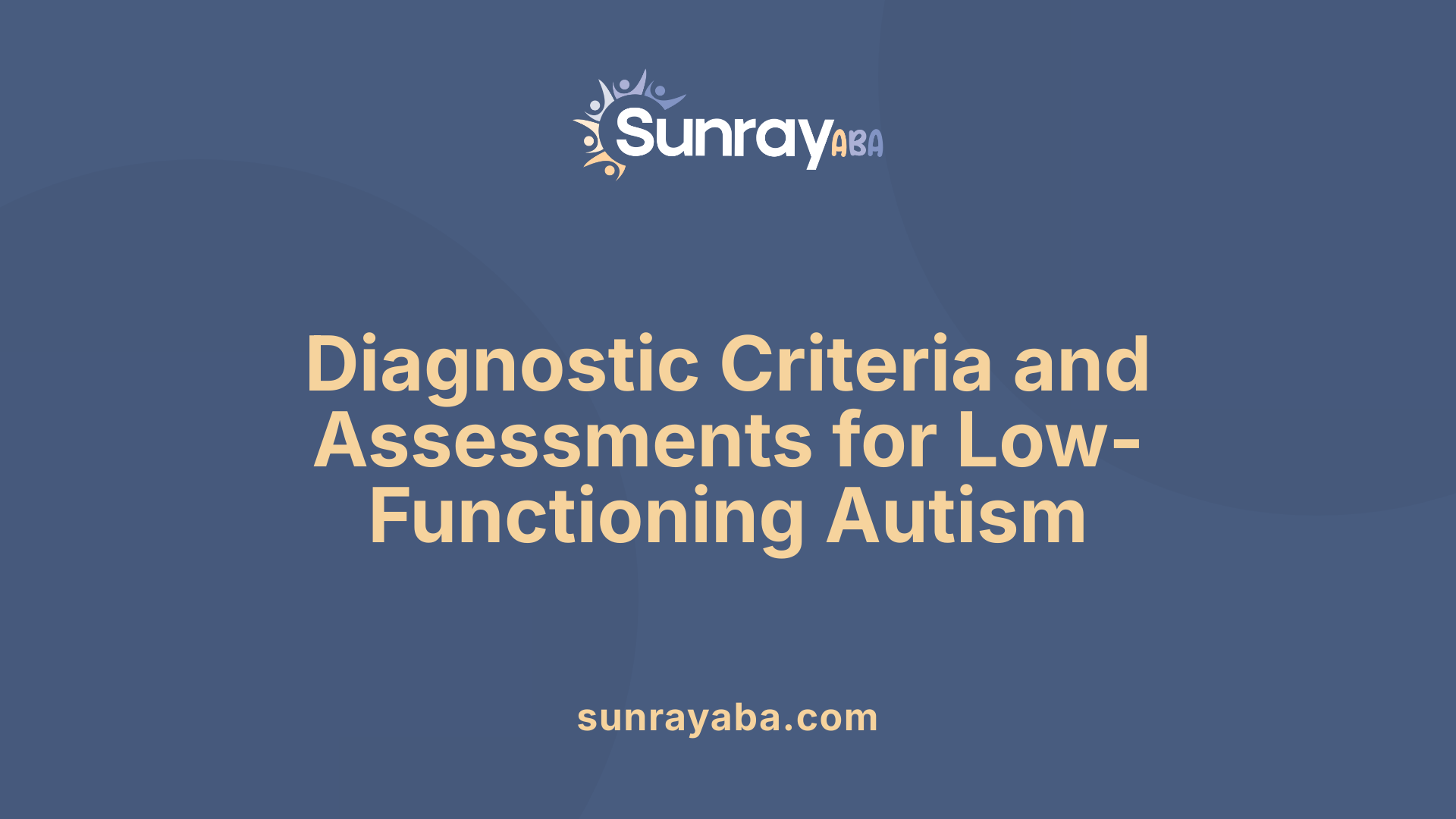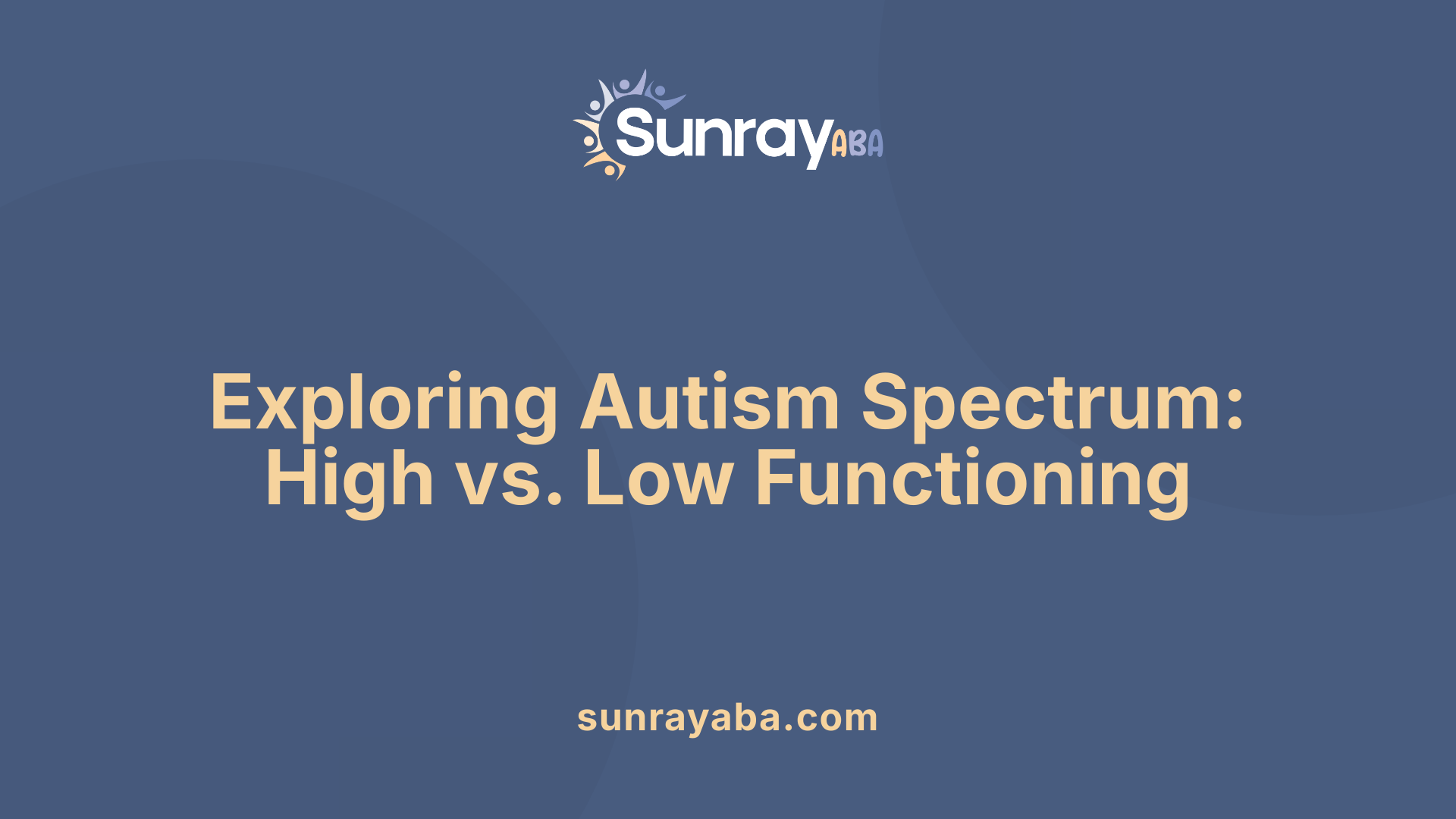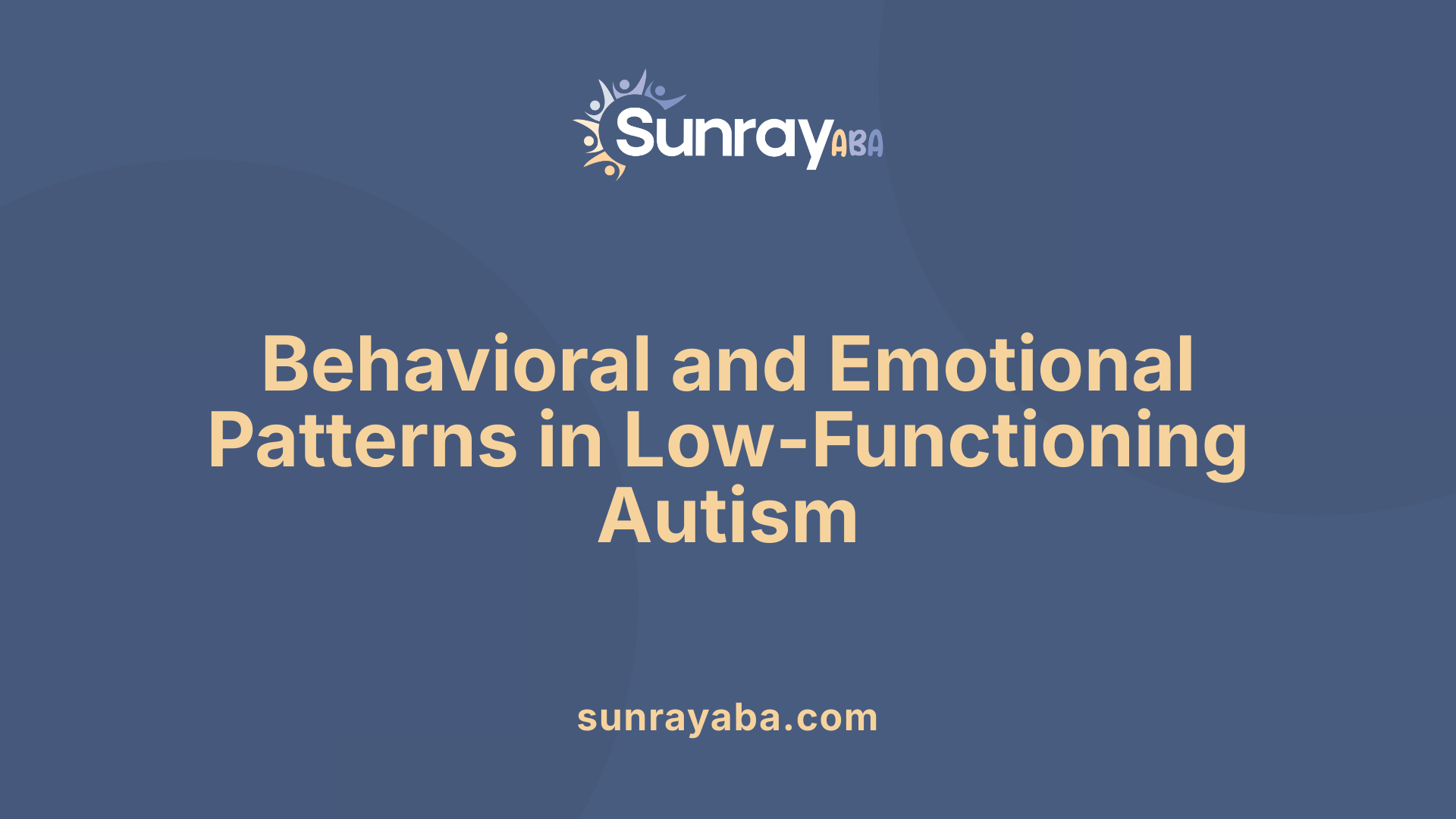Low-Functioning Autism

Exploring Low-Functioning Autism
Low-functioning autism (LFA) represents the segment of the autism spectrum characterized by the most severe symptoms, significant daily living challenges, and extensive support needs. Distinct from other forms of autism, LFA requires a comprehensive understanding of its characteristics, diagnostic process, and the tailored strategies necessary to enhance quality of life for affected individuals.
Defining Low-Functioning Autism and Its Core Characteristics

What defines low-functioning autism and what are its common characteristics?
Low-functioning autism (LFA) is a term used to describe individuals on the autism spectrum who show the most significant impairments and require extensive support. These individuals usually face severe communication difficulties, often being nonverbal or experiencing delayed language development. They struggle with the basics of daily living, including dressing, hygiene, and self-care, making independent living impossible without ongoing assistance.
Behaviorally, children and adults with low-functioning autism may display self-injury, such as hitting or biting themselves, along with repetitive behaviors like hand-flapping, rocking, or spinning. They are often hypersensitive to sensory stimuli—they may react strongly or negatively to loud sounds, bright lights, or being touched. Emotional regulation can be challenging, leading to frequent outbursts or heightened anxiety.
Many also have comorbid conditions like epilepsy or fragile X syndrome, which can increase the severity of their symptoms. Cognitive abilities in this group are typically low, with IQ scores below 80 being common. However, some individuals may have extraordinary skills in particular areas—sometimes called savant abilities—despite their overall developmental challenges.
Overall, people with low-functioning autism require lifelong support, tailored interventions, and assistance to manage behaviors and improve their quality of life. Their needs extend to medical management, behavioral therapies, and environmental adaptations tailored to their unique needs.
How the severity influences support requirements
The severity of symptoms in low-functioning autism directly impacts the level and type of support necessary. These individuals often depend on caregivers for their most basic needs, including feeding, mobility, and communication. Early diagnosis and intervention can help improve some outcomes, but many will remain highly dependent throughout their lives.
Support strategies include applied behavior analysis (ABA), speech-language therapy to improve communication, occupational therapy for motor skills, and sensory integration therapy to help process sensory inputs better. Medical treatments may also be used to address associated health issues.
This classification underscores the importance of comprehensive, individualized support plans that adapt over time as the individual’s needs evolve. Understanding these characteristics helps caregivers, educators, and clinicians provide more effective assistance and improve life quality for people with low-functioning autism.
Dissecting the Diagnostic Process for Severe Autism

What are the diagnostic criteria and assessment methods for low-functioning autism?
Diagnosing low-functioning autism involves understanding their complex behavioral and developmental profile, which is primarily guided by established criteria and assessment tools. The DSM-5 (Diagnostic and Statistical Manual of Mental Disorders, Fifth Edition) provides the framework for diagnosing Autism Spectrum Disorder (ASD). According to DSM-5, a diagnosis of ASD, including low-functioning autism, requires persistent deficits in social communication and social interaction across multiple contexts. These deficits may include challenges in social-emotional reciprocity, difficulties in understanding and using nonverbal communication such as eye contact and gestures, and trouble forming or sustaining relationships.
In addition to social deficits, individuals must exhibit restricted, repetitive patterns of behavior, interests, or activities. These behaviors may manifest as stereotyped movements (e.g., hand-flapping), insistence on sameness (e.g., strict routines), or sensory sensitivities (e.g., aversion to certain sounds or textures). These symptoms generally appear in early childhood, although they may sometimes be masked or less noticeable due to learned strategies.
To confirm a diagnosis, clinicians rely on a comprehensive part of the evaluation process, including behavioral observations, developmental history, and standardized assessment tools. Two of the most accepted instruments are the Autism Diagnostic Observation Schedule (ADOS) and the Autism Diagnostic Interview-Revised (ADI-R).
The ADOS involves structured activities designed to observe social interactions, communication skills, and repetitive behaviors directly with the individual. In contrast, the ADI-R is an extensive interview conducted with caregivers, reflecting historical and current behaviors, helping to understand the developmental trajectory.
Assessments of cognitive and adaptive functioning are also critical in this process. IQ tests, such as the Wechsler scales, help determine cognitive abilities, with many children with low-functioning autism scoring below 80. Adaptive behavior assessments, like the Vineland Adaptive Behavior Scales, measure everyday skills such as communication, daily living skills, and socialization, providing insight into functional impairments.
These diagnostic procedures collectively allow clinicians to distinguish low-functioning autism from other developmental or intellectual disabilities. Accurate diagnosis guides the development of individualized treatment plans aimed at improving daily functioning and quality of life.
| Diagnostic Aspect | Description | Additional Details |
|---|---|---|
| DSM-5 Criteria | Social communication deficits & restrictive behaviors | Manifest in early childhood, may evolve over time |
| Assessment Tools | ADOS & ADI-R | Behavioral observation & caregiver interview |
| Cognitive Testing | IQ assessments | Determines intellectual level; below 80 indicates impairment |
| Adaptive Skills Testing | Vineland Scales | Assesses daily functioning and independence |
This structured approach ensures a thorough understanding of an individual's unique needs, enabling tailored interventions and support strategies.
Understanding the Spectrum: High-Functioning vs. Low-Functioning Autism

How does low-functioning autism differ from high-functioning autism?
Low-functioning autism and high-functioning autism can be viewed as points on the autism spectrum, distinguished primarily by the level of support an individual requires and their cognitive and communication skills.
Children and adults diagnosed with low-functioning autism often have IQ scores below 80, which indicates a significant level of intellectual disability. They usually face profound challenges in verbal communication, with many being nonverbal or having delayed speech development. These individuals frequently exhibit behaviors such as self-injury, aggression, and repetitive motions like rocking or hand-flapping. Sensory disturbances, including aversions to touch, loud noises, or bright lights, are common. Their difficulties extend to managing everyday activities like dressing, grooming, and feeding without assistance.
In contrast, high-functioning autism typically refers to individuals with IQ above 80 who have better-developed language skills and social understanding. These individuals may speak fluently and comprehend social norms more readily, allowing for greater independence in daily life. They might also excel academically or possess specific talents, such as savant skills, which are exceptional abilities often associated with autism.
Support levels aligned with these distinctions also vary. According to the diagnostic criteria, low-functioning autism falls under Level 3 of the autism spectrum disorder classification, indicating a need for very substantial support throughout life. Conversely, high-functioning autism is classified as Level 1, requiring only some support in social or behavioral domains.
Despite these differences, it is essential to remember that these labels are simplifications. The spectrum is vast, and individuals within these categories can have a wide range of skills and challenges. Some high-functioning individuals may struggle with anxiety or social interactions, while some with low-functioning autism might excel in certain areas such as memory or visual-spatial skills.
Support needs and independence
Support requirements are significant in low-functioning autism — these individuals often need assistance for daily routines, communication, and behavioral management. They seldom live independently and often benefit from structured environments, therapies, and caregiver support.
On the other hand, those with high-functioning autism may manage many daily tasks independently or with minimal support. They can often hold jobs, maintain relationships, and navigate social environments, though they might still experience social challenges or anxieties.
Variability within the spectrum
One important aspect of understanding autism is recognizing the variability within the spectrum.
Some individuals classified as high-functioning may have difficulty with executive functioning, social nuances, or emotional regulation despite having higher IQs and verbal skills.
Similarly, some with low-functioning autism can make progress through targeted interventions, improving communication skills and reducing problematic behaviors.
Table 1: Comparing Low- and High-Functioning Autism
| Aspect | Low-Functioning Autism | High-Functioning Autism |
|---|---|---|
| Typical IQ range | Below 80 | Above 80 |
| Language skills | Nonverbal or speech delays | Fluent speech, good language skills |
| Support needs | Intensive support for daily activities and communication | Limited support, often functional independence possible |
| Communication abilities | Limited, often nonverbal | Verbal, understanding social cues |
| Behavioral challenges | Severe, including self-injury and aggression | Less severe, may include sensory sensitivities |
| Social skills | Significant impairments, often limited social interaction | May struggle with social nuances but better social understanding |
| Independence in daily life | Usually dependent on caregiver | Can often live independently |
| Diagnostic level | Level 3 (most severe support needs) | Level 1 (requiring support) |
Moving toward individualized understanding
While these categories serve as useful guidelines, it's vital for educators, caregivers, and clinicians to move beyond labels. Focus on the individual’s specific needs, abilities, and interests when planning support and interventions.
Accurate assessment of adaptive functioning using tools such as the Vineland Adaptive Behavior Scales helps tailor programs that promote the most meaningful progress. Approaches such as Applied Behavior Analysis (ABA), speech therapy, occupational therapy, and sensory integration therapy are common interventions that aid individuals across the spectrum.
In summary, recognizing the differences between low and high-functioning autism helps in providing appropriate support and fostering growth, but understanding the person's unique profile remains most important. The spectrum encompasses a diversity of talents and challenges, emphasizing the need for personalized strategies rather than rigid categories.
Behavioral and Emotional Manifestations

What are common symptoms and behavioral patterns associated with low-functioning autism?
Children with low-functioning autism exhibit a range of profound behavioral and emotional challenges. One of the hallmark features is severe difficulty with communication. Many children are nonverbal or rely heavily on echolalia, which means repeating words or phrases they hear. Speech delays are common, and expressive language may be minimal or absent.
Repetitive behaviors are another prominent aspect. These can include hand-flapping, rocking, spinning, or lining up objects, which serve as self-stimulating activities to soothe sensory overload or manage anxiety. These movements are often stereotyped and can be persistent and intense. In addition, individuals tend to develop rigid routines and rituals, becoming distressed if their established routines are disrupted.
Sensory processing issues are widespread among children with low-functioning autism. They may be hypersensitive or hyposensitive to sensory stimuli such as bright lights, loud noises, or tactile sensations. For example, they might avoid being touched or become overwhelmed in noisy environments, leading to sensory aversions.
Behavioral issues such as aggression, self-injury, and meltdowns are common. These behaviors often occur as responses to frustration, difficulty understanding their environment, or sensory overload. Self-injurious actions like biting, hitting, or head-banging can be severe and require careful management.
Emotional regulation is typically impaired, resulting in frequent outbursts, high anxiety levels, and difficulties coping with change. These challenges can also impact sleep patterns, leading to insomnia or irregular sleep routines.
Cognitive impairments often accompany these behaviors, with many children exhibiting intellectual disabilities that limit their ability to manage daily tasks independently. Overall, children with low-functioning autism require comprehensive, individualized support to help them navigate their environment and improve their quality of life.
Detailed Overview of Behavioral Symptoms
| Symptom/Behavior | Description | Impact |
|---|---|---|
| Severe communication deficits | Nonverbal or echolalia, minimal speech development | Limits social interaction and learning opportunities |
| Repetitive behaviors | Hand-flapping, rocking, spinning, lining objects | Provides sensory regulation and comfort |
| Sensory sensitivities | Over- or under-reactivity to lights, sounds, touch | Can cause distress, avoidance behaviors |
| Self-injury and aggression | Hitting, biting, head-banging | Potentially harmful behaviors requiring intervention |
| Rigidity and routines | Strict adherence to routines, distress at changes | Impairs flexibility, increases anxiety |
| Emotional outbursts | Tantrums, meltdowns, frustration outbursts | Disruptive behaviors that may require behavioral support |
| Anxiety and frustration | Elevated anxiety levels, difficulty calming | Affects emotional well-being and daily functioning |
Focused Questions and Comprehensive Response
What are common symptoms and behavioral patterns associated with low-functioning autism? Children with low-functioning autism commonly exhibit severe communication deficits, often being nonverbal or relying on echolalia and repetitive speech patterns. They typically display intense repetitive behaviors such as hand-flapping, rocking, or spinning, along with restricted routines and rituals, and may have sensory sensitivities to light, sound, or touch. Social interaction skills are significantly impaired, with difficulties in understanding nonverbal cues, poor eye contact, and limited engagement, often accompanied by behavioral issues like aggression or self-injury. Many experience emotional outbursts, frustration, and difficulty adapting to changes, which can lead to trouble sleeping and heightened anxiety. Additionally, these individuals usually have intellectual disabilities and may require lifelong support to manage daily activities and challenges.
Additional Information on Behavioral Patterns in Severe Autism
Understanding sensory processing issues and behavioral patterns in children with severe autism can help caregivers and professionals develop more effective strategies for support and intervention. Recognizing these behaviors as communication methods or coping mechanisms is vital in creating a supportive environment that promotes safety and development.
Strategies for Effective Treatment and Support

What treatment options and support strategies are available for individuals with low-functioning autism?
Children and adults with low-functioning autism face unique challenges that require tailored treatment and support plans. The goal is to improve their quality of life, safety, and ability to participate in daily activities.
One of the most effective approaches is behavioral therapy, particularly applied behavior analysis (ABA). ABA is highly evidence-based and focuses on teaching skills through positive reinforcement. It aims to increase adaptive behaviors such as communication and independence while reducing problematic behaviors like self-injury and aggression.
Speech therapy is also crucial, especially since many individuals with low-functioning autism are nonverbal or have delayed speech development. Speech-language therapists work to improve communication skills, using tools like picture exchange communication systems (PECS) or augmentative and alternative communication (AAC) devices.
Occupational therapy helps develop fine motor skills, sensory integration, and daily living skills such as dressing, grooming, and feeding. Therapists work to reduce sensory sensitivities and improve tolerance to environmental stimuli like noise and touch.
Educational environments tailored for learners with severe autism often employ structured strategies such as those used in TEACCH programs. These strategies emphasize visual supports, visual schedules, and a predictable routine to create a stable learning environment. Consistency and clear expectations help reduce anxiety and behavioral outbursts.
Support strategies extend beyond therapy and education. Family involvement is essential, with training provided to caregivers to implement consistent behavioral plans and facilitate skill generalization in natural settings.
Addressing co-occurring conditions—such as anxiety, seizures, or gastrointestinal issues—is often part of a comprehensive treatment plan. Medications may be prescribed to manage specific symptoms or medical conditions.
Safety is a primary concern for individuals with low-functioning autism. Techniques like safety-proofing the environment, tracking devices, and supervised routines help prevent wandering and self-harm.
Overall, a multidisciplinary approach centered on individual needs is vital. These interventions aim not only to enhance immediate functioning but also to promote independence and social participation, enabling individuals to live as safely and fully as possible.
Summary Table of Support Strategies:
| Strategy Type | Specific Interventions | Objective | Additional Notes |
|---|---|---|---|
| Behavioral Therapy | Applied Behavior Analysis (ABA) | Improve communication and reduce harmful behaviors | Tailored to individual's needs |
| Speech Therapy | AAC systems, picture exchange | Enhance communication skills | Critical for nonverbal individuals |
| Occupational Therapy | Sensory integration, daily living skills | Develop motor and sensory skills | Helps manage sensory sensitivities |
| Educational Approaches | Visual supports, structured routines | Facilitate learning | Promotes predictability and reduces anxiety |
| Family and Community Support | Caregiver training, social skills training | Promote generalization of skills | fosters independence |
| Medical Management | Medications for specific conditions | Address co-occurring issues | Includes anticonvulsants, anxiolytics |
| Safety Measures | Environment safety proofing, tracking devices | Ensure safety | Prevent wandering and injuries |
By combining these strategies, support for individuals with low-functioning autism can be comprehensive and effective. The focus remains on individualized planning, emphasizing real-world skills and safety to improve everyday quality of life.
Educational Approaches for Severe Cognitive Disabilities in Autism
What educational approaches support individuals with severe cognitive disabilities on the autism spectrum?
Individuals with severe cognitive challenges and autism require specialized, individualized educational strategies. These approaches are designed to promote communication, develop daily living skills, and support behavioral growth.
Structured teaching methods such as TEACCH (Top-down, Environment, and Automatic-initiations of Communication with a focus on Contexts for the Deaf and Hard of Hearing) and DTT (Discrete Trial Training) are widely used. TEACCH emphasizes visual supports and structured routines which help individuals understand expectations and reduce sensory overload. DTT breaks down skills into small, manageable steps, providing clear prompts and reinforcement, fostering learning through repetition.
Another essential component is the use of augmentative and alternative communication (AAC) systems. These include picture boards, communication devices, and sign language, enabling non-verbal or minimally verbal individuals to express their needs and participate socially.
Creating supportive learning environments involves sensory and environmental modifications. These adjustments reduce distractions and sensory sensitivities, such as bright lights or loud noises, which can otherwise hinder focus and comfort. Visual schedules, quiet zones, and sensory-friendly activities are crucial components.
In addition to structured behavioral therapies, developmental models like the Early Start Denver Model (ESDM) focus on fostering social engagement and early learning. Behavioral supports rooted in Applied Behavior Analysis (ABA) are effective in encouraging positive behaviors and decreasing harmful or disruptive actions.
Social-relational strategies, including Social Stories and DIR/Floor Time, are designed to promote understanding of social cues and emotional connections, aiding in social integration. These tools help individuals grasp routines and social norms at an appropriate developmental level.
In summary, comprehensive, tailored educational strategies that combine behavioral techniques, communication supports, sensory accommodations, and social-emotional strategies are essential for supporting individuals with severe autism. These approaches aim to maximize functional independence and improve quality of life, recognizing that progress varies widely among individuals.
Evolving Perspectives and Controversies in Autism Classification
Are there current debates on how autism should be classified in terms of functioning levels?
Yes, there is active discussion in the autism community and among experts about how to best categorize autism spectrum disorder (ASD). Traditionally, labels like 'high-functioning' and 'low-functioning' were used to describe individuals based largely on their cognitive ability, language skills, and support needs.
Many professionals criticize these labels because they tend to oversimplify the complex, varied experiences of people with autism. Such terms can inadvertently reinforce stereotypes, stigmatize individuals, and ignore individual strengths and interests.
The introduction of support level categories in the DSM-5 has aimed to provide a more detailed perspective. These levels—Level 1 (requiring some support), Level 2 (requiring substantial support), and Level 3 (requiring very substantial support)—focus on the amount of assistance needed rather than just cognitive or language ability.
This shift promotes a more nuanced understanding that recognizes the potential for change over time and the diverse needs of individuals. It also encourages tailored interventions and supports, rather than one-size-fits-all labels.
Furthermore, distinctions between diagnoses like Asperger Syndrome and High-Functioning Autism have contributed to ongoing debates. Some argue these distinctions are helpful, while others suggest they may cause confusion or false distinctions, given the spectrum nature of autism.
Support for severity-based levels in DSM-5
The DSM-5’s classification system represents a move toward describing functioning based on support needs. This approach emphasizes how autism symptoms impact daily life and the individual's ability to perform activities, rather than solely relying on IQ scores or language ability.
It aims to foster personalized care plans, recognizing that two individuals with similar IQ levels may have vastly different support requirements and life experiences. This classification also aids in establishing clearer guidelines for educational, social, and medical interventions.
Movements toward more descriptive and functional terminology
The autism community and many researchers advocate for a shift toward descriptive, functional language. Instead of labels that suggest fixed levels of capability, they promote describing actual abilities and challenges.
Examples include specifying speech patterns ('few-to-no words,' 'some single words,' 'fluent speech'), or functional abilities in daily living. This approach supports a person-centered perspective and helps track progress more accurately.
There is also increased emphasis on measuring adaptive behaviors—skills used in everyday life—through tools like the Vineland Adaptive Behavior Scales. These measures provide insights into how individuals manage daily tasks, social interactions, and independent living.
Overall, these developments reflect a broader movement to move away from rigid labels toward a flexible, individualized understanding of autism. This not only fosters more compassionate care but also empowers individuals and families to focus on strengths and tailored support strategies.
| Classification System | Focus Level | Main Features | Strengths | Limitations |
|---|---|---|---|---|
| Traditional Labels ('High/Low') | Cognitive & Language Ability | Simplistic, often stigmatizing | Easy to understand but often misleading | Oversimplification, ignores individual variability |
| DSM-5 Support Levels | Support Needs | Describes daily functioning and support requirements | More nuanced, adaptable, person-centered | Can still be broad and sometimes inconsistent |
| Descriptive Functional Terms | Actual Skills & Abilities | Specifies communication, daily life skills | Highly personalized, measurable progress | May lack clarity for broad classification |
Sources and ongoing debates emphasize the importance of moving toward models that reflect the diversity and individuality of people with autism. The goal is to support their unique needs effectively while respecting their strengths and life circumstances.
Moving Toward a More Nuanced Understanding
As the understanding of autism spectrum disorder advances, it is vital to recognize the limitations of traditional labels like 'low-functioning' and 'high-functioning'. The focus is shifting toward individualized assessments that consider adaptive behavior, communication abilities, support needs, and personal strengths. This approach fosters more compassionate, effective interventions and educational strategies, emphasizing that each person’s autism profile is unique and dynamic. Recognizing the diversity within the spectrum encourages a more inclusive and supportive society that respects the full range of abilities and challenges faced by individuals with autism.
References
- Low Functioning Autism: Symptoms and Therapies
- Low Functioning Autism: The Levels, Signs, Symptoms - AngelSense
- Teaching Students Who Are Low Functioning: Who Are They and ...
- Low-Functioning Autism: All You Should Know
- Classic autism - Wikipedia
- Describing function in ASD: Using the DSM-5 and other methods to ...
- High functioning vs. low functioning autism: what is the difference?
- High-Functioning Autism vs. Low-Functioning Autism - Integrity, Inc.